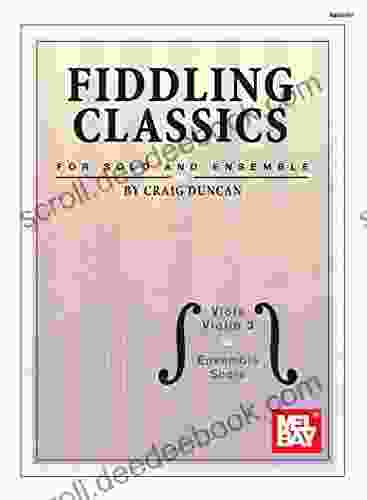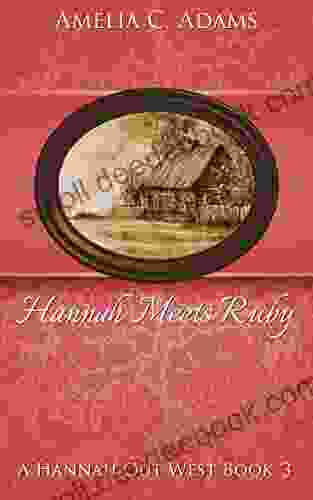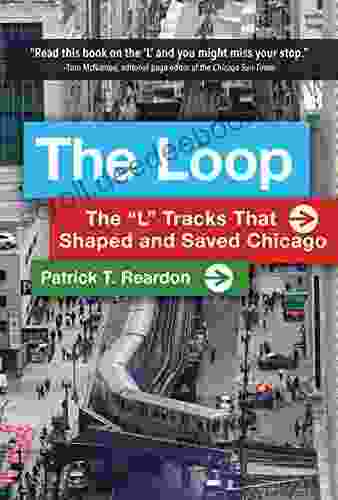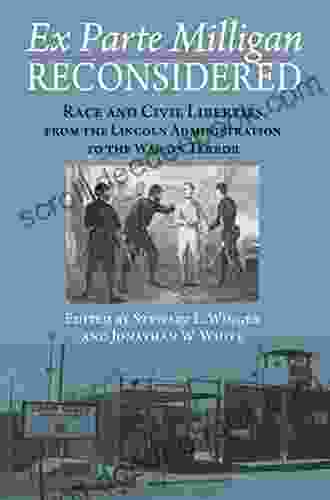The Tracks That Shaped and Saved Chicago: A Walk Through Time

Chicago, known as the "Windy City," is a vibrant metropolis with a rich history and thriving culture. At its heart lies a network of railways that played a pivotal role in shaping the city's destiny and transforming it into the transportation hub it is today. These tracks, spanning miles and connecting distant corners, have borne witness to the city's triumphs, trials, and growth. Join us on a captivating journey as we delve into the stories behind the tracks that shaped and saved Chicago.
The Early Years: Connecting the Midwest
Chicago's railway story began in the mid-19th century when the city became a crucial junction for railroads connecting the Eastern seaboard to the expanding Midwest. In 1848, the first railroad bridge over the Chicago River opened, connecting the city to the east and the west. This vital link sparked a surge in trade and commerce, laying the foundation for Chicago's economic prosperity.
4.7 out of 5
| Language | : | English |
| File size | : | 7136 KB |
| Text-to-Speech | : | Enabled |
| Enhanced typesetting | : | Enabled |
| Word Wise | : | Enabled |
| Print length | : | 312 pages |
| Screen Reader | : | Supported |
| Hardcover | : | 105 pages |
| Item Weight | : | 15.5 ounces |
| Dimensions | : | 5.55 x 1.22 x 8.86 inches |
| Paperback | : | 352 pages |
As the city grew, so did the need for transportation. By the 1870s, six major trunk lines converged on Chicago, carrying goods and passengers from all over the country. The presence of these railroads transformed Chicago into a distribution and manufacturing center, attracting businesses and industries from far and wide.
The Great Fire and the Rise of the "L"
In 1871, a devastating fire swept through Chicago, destroying much of the city. In the aftermath, the need for safe and efficient transportation became paramount. The response was the construction of the elevated railway, commonly known as the "L." This innovative system, with its elevated tracks and steam-powered trains, provided a rapid and reliable means of transportation for the rebuilding city.
The "L" not only aided in the reconstruction but also shaped Chicago's urban landscape. The elevated lines crisscrossed the city, connecting neighborhoods and shaping the city's growth patterns. The construction of the "L" also led to the development of iconic stations, such as Union Station and Grand Central Station, which became landmarks in their own right.
The Expansion of the Rail Network
As the city expanded, so did the railway network. In the early 20th century, electric streetcars supplemented the elevated lines, providing more extensive and affordable transportation options. The city invested heavily in infrastructure, building bridges, tunnels, and viaducts to accommodate the growing rail traffic.
The expansion of the rail network played a crucial role in the development of Chicago's suburbs. Commuting became easier, allowing people to live outside the city limits and still access jobs and amenities in the urban center. The suburbs flourished, becoming home to a growing population of Chicagoans.
The Post-War Boom and the Golden Age of Railroads
Following World War II, Chicago experienced a period of economic and population growth. The railroads continued to play a vital role in the city's prosperity, transporting goods and passengers to and from the expanding urban area. The 1950s and 1960s marked the "Golden Age of Railroads" in Chicago, with sleek passenger trains and freight lines operating at peak efficiency.
However, the mid-20th century also witnessed the rise of alternative modes of transportation, such as automobiles and airlines. The growth of the suburbs and the increasing popularity of car ownership led to a decline in passenger rail traffic. The railroads had to adapt to changing times and find new ways to maintain their relevance in the transportation landscape.
The Renaissance of the Rails
In recent years, Chicago has experienced a resurgence of interest in rail transportation. The city has invested heavily in infrastructure upgrades, including the construction of new rail lines and the modernization of existing ones. The "L" system, once a symbol of urban blight, has undergone extensive renovations and now offers safe and reliable transportation to Chicagoans.
The renaissance of the rails is also evident in the development of commuter rail lines, such as Metra, which connect Chicago to its surrounding suburbs. These lines provide convenient and cost-effective transportation options for commuters, reducing traffic congestion and improving air quality.
Green Initiatives and Sustainable Transportation
In keeping with its commitment to sustainability, Chicago is exploring innovative ways to integrate rail transportation with environmentally friendly initiatives. The city has invested in electric and hybrid railcars to reduce emissions and promote clean air. Additionally, the expansion of bike-sharing programs and the implementation of dedicated bike lanes allow for seamless intermodal transportation, encouraging commuters to combine cycling with rail travel.
The Future of Rail in Chicago
As Chicago continues to evolve, the railways that have shaped its past will undoubtedly play a vital role in its future. Ongoing investments in infrastructure and the adoption of sustainable transportation practices will ensure that the tracks that shaped Chicago will continue to serve and support the city's growth and prosperity. The railways will remain an integral part of Chicago's transportation landscape, connecting people, businesses, and communities for generations to come.
The railways of Chicago are more than just lines of steel and wood; they are the threads that have woven together the fabric of the city's history, culture, and economy. From the early days of connecting the Midwest to the present-day focus on sustainability, the tracks have played a pivotal role in shaping Chicago into the vibrant metropolis it is today.
As we look ahead to the future, the railways will continue to be a driving force in the city's growth and development. By investing in infrastructure, embracing innovation, and prioritizing sustainable practices, Chicago will ensure that the tracks that shaped and saved the city will continue to serve the needs of its people and contribute to its prosperity for generations to come.
4.7 out of 5
| Language | : | English |
| File size | : | 7136 KB |
| Text-to-Speech | : | Enabled |
| Enhanced typesetting | : | Enabled |
| Word Wise | : | Enabled |
| Print length | : | 312 pages |
| Screen Reader | : | Supported |
| Hardcover | : | 105 pages |
| Item Weight | : | 15.5 ounces |
| Dimensions | : | 5.55 x 1.22 x 8.86 inches |
| Paperback | : | 352 pages |
Do you want to contribute by writing guest posts on this blog?
Please contact us and send us a resume of previous articles that you have written.
 Book
Book Page
Page Chapter
Chapter Story
Story Genre
Genre Reader
Reader Library
Library Paperback
Paperback E-book
E-book Magazine
Magazine Sentence
Sentence Glossary
Glossary Bibliography
Bibliography Foreword
Foreword Preface
Preface Synopsis
Synopsis Scroll
Scroll Tome
Tome Bestseller
Bestseller Classics
Classics Memoir
Memoir Character
Character Resolution
Resolution Librarian
Librarian Catalog
Catalog Card Catalog
Card Catalog Borrowing
Borrowing Periodicals
Periodicals Research
Research Scholarly
Scholarly Lending
Lending Journals
Journals Reading Room
Reading Room Special Collections
Special Collections Interlibrary
Interlibrary Study Group
Study Group Thesis
Thesis Dissertation
Dissertation Storytelling
Storytelling Theory
Theory Tim Minchin
Tim Minchin Jethro Soutar
Jethro Soutar The Editors Of Blue Shoe Press
The Editors Of Blue Shoe Press Chris Andre
Chris Andre Matt Gates
Matt Gates Craig Duncan
Craig Duncan Lauren Leslie
Lauren Leslie Halyma Khanam
Halyma Khanam Raymond Benson
Raymond Benson Terri Reed
Terri Reed David Horton
David Horton Melvin M Belli
Melvin M Belli Jane Hirshfield
Jane Hirshfield Ray Pratt
Ray Pratt David L Newman
David L Newman Bella Hope Shiloh
Bella Hope Shiloh David Bailey
David Bailey Amanda Lera
Amanda Lera Peter Prange
Peter Prange Barbara A Somervill
Barbara A Somervill
Light bulbAdvertise smarter! Our strategic ad space ensures maximum exposure. Reserve your spot today!

 Truman CapoteTo Have and to Hold: An Epic Tale of Love, Loss, and Redemption Amidst the...
Truman CapoteTo Have and to Hold: An Epic Tale of Love, Loss, and Redemption Amidst the...
 Emmett MitchellFiddling Classics for Solo and Ensemble: A Comprehensive Guide to Playing and...
Emmett MitchellFiddling Classics for Solo and Ensemble: A Comprehensive Guide to Playing and... Edgar Allan PoeFollow ·8k
Edgar Allan PoeFollow ·8k Ian McEwanFollow ·13.8k
Ian McEwanFollow ·13.8k Orson Scott CardFollow ·10.5k
Orson Scott CardFollow ·10.5k Natsume SōsekiFollow ·6.2k
Natsume SōsekiFollow ·6.2k Ashton ReedFollow ·11.4k
Ashton ReedFollow ·11.4k Troy SimmonsFollow ·2.8k
Troy SimmonsFollow ·2.8k Michael SimmonsFollow ·5.9k
Michael SimmonsFollow ·5.9k Kazuo IshiguroFollow ·2.4k
Kazuo IshiguroFollow ·2.4k

 Howard Powell
Howard PowellDk Workbooks Science Third Grade: An In-Depth Exploration...
Science education plays a...

 Everett Bell
Everett BellLearn to Play Bluegrass Dobro Guitar: A Comprehensive...
: Bluegrass Dobro, A Story of...

 Jeffrey Cox
Jeffrey CoxHow the Raccoon Got His Mask
The raccoon, with its...

 George Bell
George BellHannah Meets Ruby Hannah Out West: An Adventure-Filled...
Hannah Meets...
4.7 out of 5
| Language | : | English |
| File size | : | 7136 KB |
| Text-to-Speech | : | Enabled |
| Enhanced typesetting | : | Enabled |
| Word Wise | : | Enabled |
| Print length | : | 312 pages |
| Screen Reader | : | Supported |
| Hardcover | : | 105 pages |
| Item Weight | : | 15.5 ounces |
| Dimensions | : | 5.55 x 1.22 x 8.86 inches |
| Paperback | : | 352 pages |












